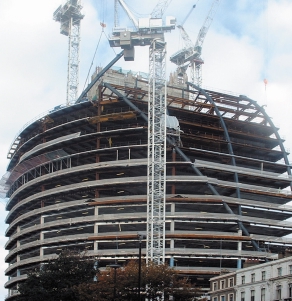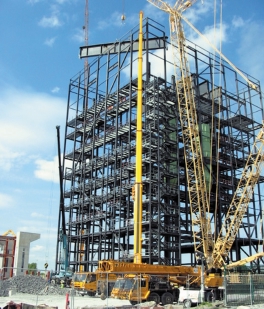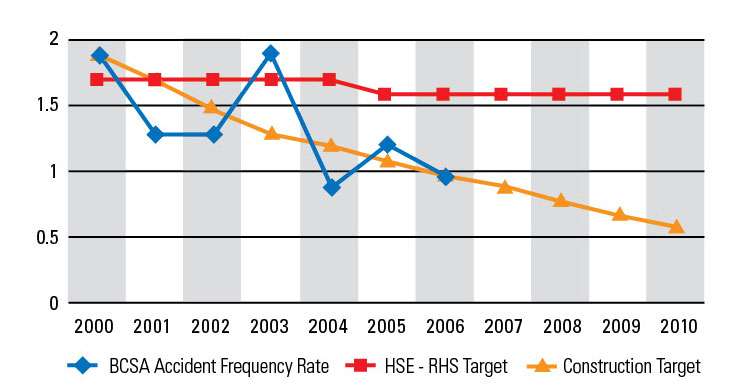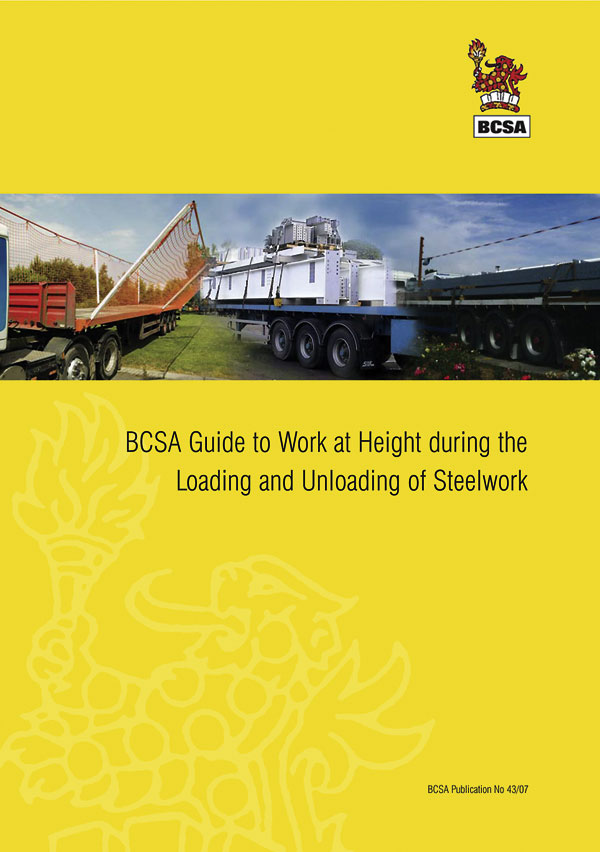Projects and Features
Health & Safety in Steel Construction
Major developments are taking place in all aspects of health and safety in steel construction.
WORK AT HEIGHT
The UK Government, through the Health & Safety Executive (www.hse.gov.uk), has published draft new regulations for working at height (WAH). The draft proposals can be downloaded from the HSE website. “Height” no longer has a minimum definition, e.g. 2m, but now means “any height above ground”; hence all operations and industries are likely to be affected. The BCSA H&S Group notes that guidance on the use of MEWPS (Mobile Elevating Working Platforms) is included in the new draft regulations. BCSA member companies have differing requirements for the use of fall arrest/restraint equipment in mobile platforms. A meeting is to take place with the MEWP manufacturers to try to establish manufacturers’ instructions on anchor points in the basket. There is a clause in the draft WAH Regulations allowing for climbing out of MEWP baskets, hence it has been agreed to invite the HSE to the sub-group meeting.
LOADING AND UNLOADING LORRIES
A meeting has been held with HSE to discuss the implications of the WAH Regulations for the loading and unloading of lorries. It was noted that as yet no solution was available, but that an HSE Group is looking into this. A partial solution is to build platforms at the side of lorries. Various methods of “clothes line” and “folding nets” systems were reviewed. Current solutions rely on the use of trained people, procedures etc and the use of anchor points where possible. The HSE has also published a consultation document on deliveries and collections: cooperating to prevent workplace vehicle accidents.
MANUAL HANDLING
A new procedure assessment system is available on the HSE website. Some companies have started in-house training with qualified trainers (three day training courses are available).
SKILLS CARDS
All construction site personnel now have to have credit card type “skills cards” which demonstrate their level of competence and training. There is a CSCS/BCSA card for erectors and site fabricators. As yet that there are no recognised NVQs or skills cards for deckers and cladders. The H&S Group has proposed to include a new module to cover this within the erector card NVQ.
H&S PASSPORTS
Individuals are now able to obtain “passports” to demonstrate that they have received training on H&S issues for both the factory and the site.
BCSA H&S PUBLICATIONS
The BCSA already publishes a number of H&S guides including Office, Workshop, Site and Managers & Supervisors. In addition the Safe Site Hanover Certificate provides a checklist approach for members and main contractors to use when defining/handing over a site safe for steel erection. The BCSA is planning to publish three new Best Practice Guides soon (Low Rise, Bridges, Decking and Studwelding) and a Multi-Storey Guide later in the year. In addition a new Guide on Erecting Steelwork in “Windy Conditions” is being developed. The BCSA Erector’s Manual is also to be revised and updated.
CODE OF PRACTICE FOR ERECTION OF LOW RISE BUILDINGS
The document is being prepared on behalf of the industry for responsible companies to follow. Thus it would be similar in status to the National Structural Steelwork Specification (NSSS), such that companies can refer to it as their norm when tendering. The document relies on the assumption that companies provide instructions for particular work items as task-specific-method-statements (e.g. for use of grinders on site, or erection, wedging and plumbing of single columns). In terms of a “glossier” document for clients, the forthcoming Corus Guide that advocates steel as the safe solution should serve that purpose.
CODE OF PRACTICE FOR METAL DECKING AND STUD WELDING
This is at a similar stage to the above and should turn out similarly as a Code of Practice. Being a more self-contained activity it will rely less on support from task specific method statements The title may need amending to clarify that it only refers to site work.
GUIDE TO ERECTION OF STEEL BRIDGES
This is a different type of document as it is less of a Code of Practice for bridgework contractors than a guide for designers, hence the difference in title. This is because the bridgework contractors start from generally the highest level of competence and do not “need” to be told what to do by an industry Code of Practice. Instead the document is aimed at educating clients, designers and principal contractors as to the issues they face.
ERECTING STEELWORK IN WINDY CONDITIONS
This is likely to be split into two documents:
(i) A two-page key points guide for erectors and others on site.
(ii) A document intended for designers and erection planners.
SCCS AUDITING
The Steel Construction Certification Scheme (SCCS) is now able to offer a H&S Certification service and several companies have already been audited. SCCS is in discussion with the Association of British Insurers regarding reduced Employers’ Liability insurance costs for certified companies.
OCCUPATIONAL ILL-HEALTH
Companies report that there are very differing callback rates following tests depending whether a doctor, nurse or hospital is used for checks, with the doctor or nurse route being better. Agreement on the frequency of testing can be a problem, but once a system is in place it helps to reduce insurance claims. It has been noted that a summary of the legislation requirements would be beneficial to facilitate a more uniform approach by members to testing; hence BCSA has approached the HSE’s Employment Medical Advisory Service (EMAS) with a view to developing a list of the tests required, relevant legislation and frequency of testing. The implications of the Data Protection Act and Human Rights Legislation would need to be considered. It was envisaged that the list of tests would include: audio; HAV; fitness for shiftwork; nightwork; eyesight; mental capability; stress; skin disorders; VDU screens; work related limb disorders; drugs; alcohol; muscoskeletal.
OTHER CURRENT H&S TOPICS
- Self-escorting of abnormal loads is now allowed.
- SCOSS is seeking practical guidance for designers on health issues, e.g. painters.
- New regulations on solvent emissions had been published.
- The SCI is doing research on “Lifting Safely”.
- Implications of Data Protection and RIDDORS; one person should be appointed to receive reports and individuals’ names should not be included in management accident reports.
- The new paint emission requirements are likely to be difficult to meet.
- Fire alarm systems are becoming standard practice in factories.
Dr Derek Tordoff, Director General of the BCSA.
















